Motorola Droid Bionic Review - Dual Core with 4G LTE
by Brian Klug on October 11, 2011 1:55 AM EST- Posted in
- Smartphones
- LTE
- Motorola
- OMAP 4
- Mobile
- motorola droid bionic
Software and Performance
The Bionic comes with Motorola’s new Motoblur, just like I saw on the Droid 3. You can go pull the specific version from build.prop:
Blur_Version.5.5.886.XT875.Verizon.en.US
It includes a custom lock screen which gets some different styling and a slide left-right unlock scheme. The theme also includes an CRT off animation, which seems to be an approximation of the off animation from Android 2.3. The Bionic as we reviewed it was running Android 2.3.4, which is new but not absolute bleeding edge.
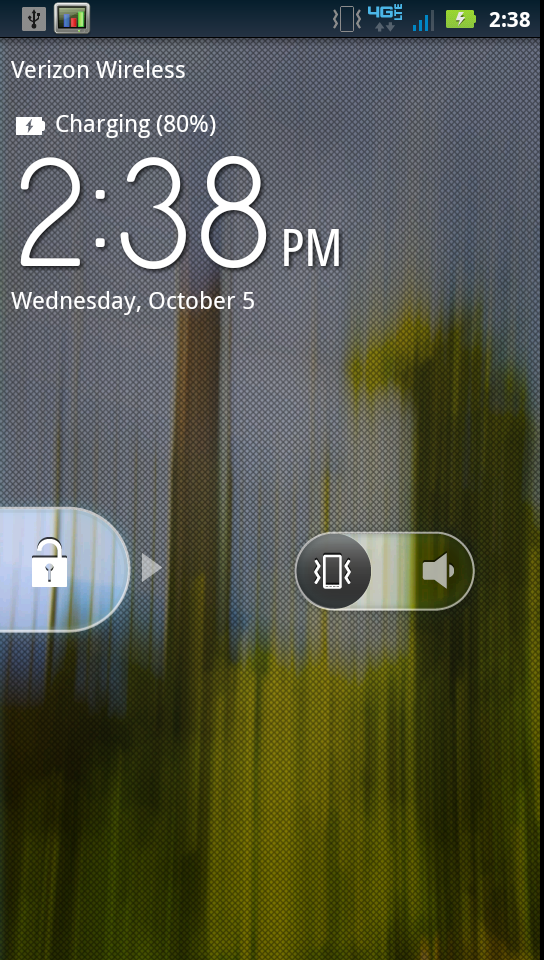
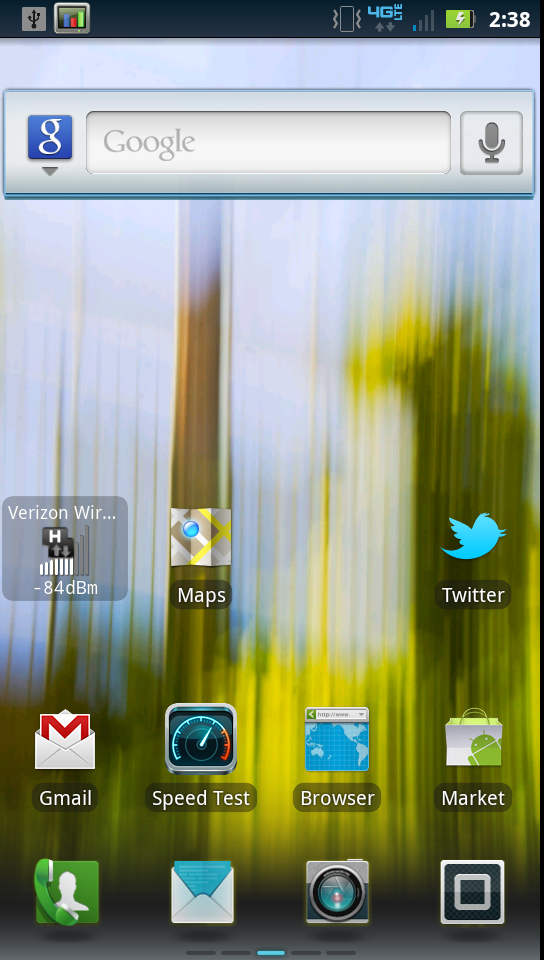
All the usual Motoblur accoutrements are here, including a black on grey theme for settings and menus, and blue elsewhere for the shade and highlighting colors.

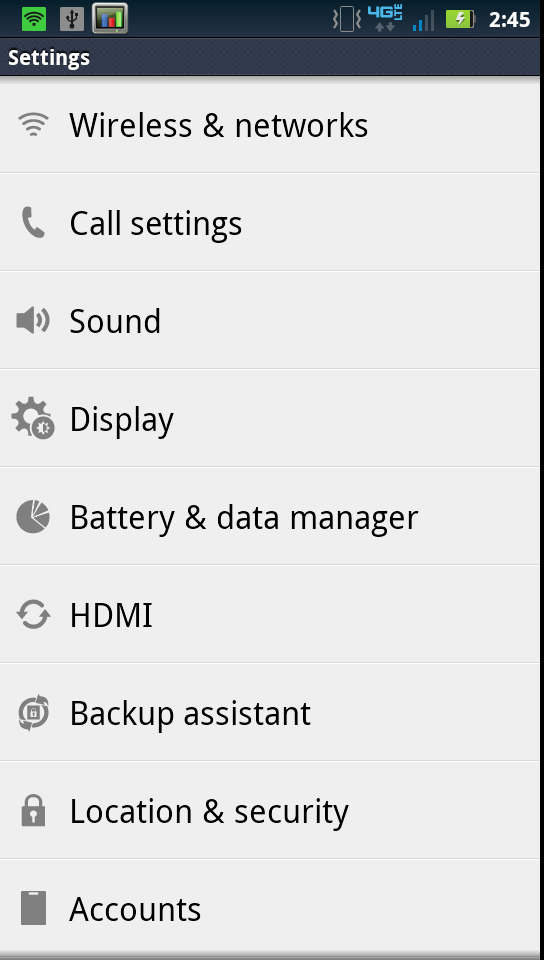
The home screens get the same kind of 3D composition I saw on the Droid 3, and feel pretty smooth panning back and forth. The only thing I’ve noticed this time is that it looks like the color depth here on the background seems to be 16 bit (RGB 565). I bet this is due to some GPU composition going on which makes things nice and speedy.
Pretty much the same applies to the launcher, where you get a paginated 4x5 grid of icons that can be sorted alphabetically or grouped. The Bionic does come with an assortment of preloaded stuff that’s entirely par for Verizon. Some things can be removed without root, other things can’t. I feel like we’re getting closer to the point where users are given the ability to uninstall stuff without root, but it still isn’t here yet.
Going over the storage situation on the Droid 3 is also important. By default, you get 16 GB of internal NAND, and a 16 GB class 4 microSD card. Things look like this using df:
Filesystem Size Used Free Blksize/dev 465M 388K 465M 4096/mnt/asec 465M 0K 465M 4096/mnt/obb 465M 0K 465M 4096/system 477M 332M 144M 1024/data 3G 501M 3G 4096/cache 708M 18M 689M 4096/osh 1G 650M 661M 2048/pds 3M 1M 2M 1024/preinstall 302M 187M 115M 1024/mnt/sdcard-ext 14G 11M 14G 32768/mnt/sdcard-ext 14G 11M 14G 32768/mnt/sdcard 8G 227M 7G 8192/mnt/sdcard 8G 227M 7G 8192
I’m not going to go over all of the OMAP 4430 details again since we’ve already gone in depth with the Motorola Droid 3, so I’d encourage curious minds to check that out for more detail. The short of it is that the Droid Bionic has a 1.0 GHz OMAP4430 SoC which consists of two ARM Cortex A9s with the MPE (ARM’s NEON SIMD unit), alongside PowerVR SGX 540 graphics at 304 MHz and a dual channel LPDDR2 memory interface. The Bionic has 1 GB of LPDDR2 over the Droid 3’s 512 MB of LPDDR2, but this is primarily to accommodate the increased demands from the laptop dock.
First up are the web based tests. Interestingly enough the Bionic posts an impressive result for SunSpider 0.9, I ran this test a few times as always and this wasn’t an errata. I also updated the SGS2 results with a run from the newest firmware I see on Kies, XXKI1, which is 2.3.4.
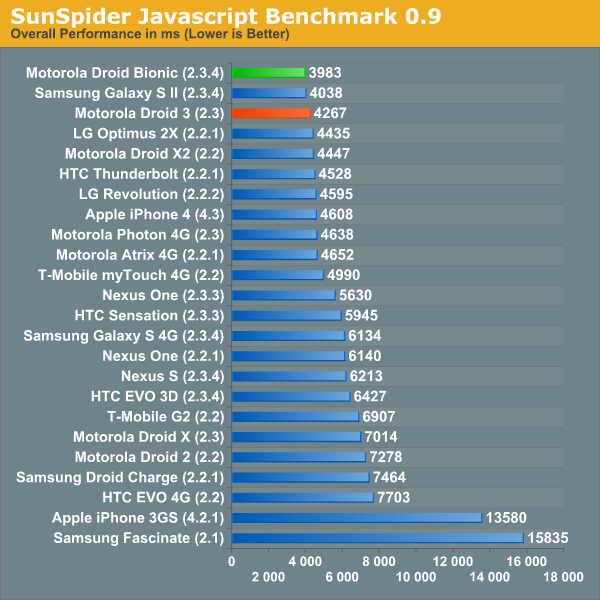
Browsermark curiously is a bit lower compared to the Droid 3 however, which is surprising since the two should be close considering the same SoC and version of Android. The results are reasonably close, however.
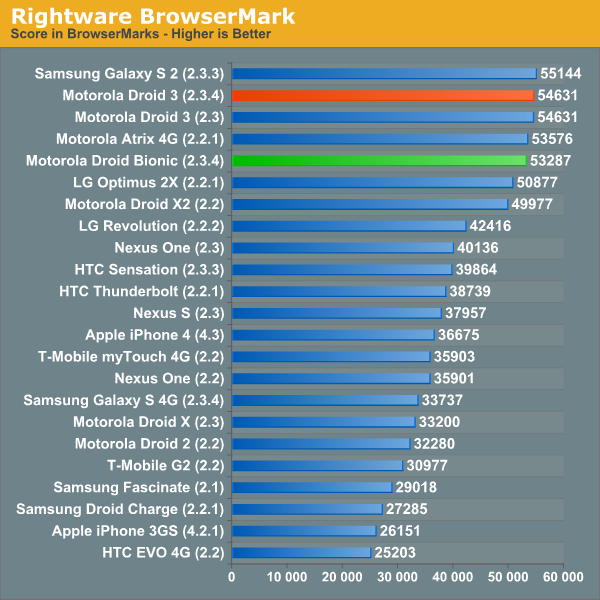
I didn’t record the Vellamo ocean flinger result from the Droid 3, however the Bionic comes in just above the Galaxy S 4G. Motorola isn’t using a backing store, rather something of a re-skinned stock Android browser, and thus scrolling performance isn’t as fluid as other devices.
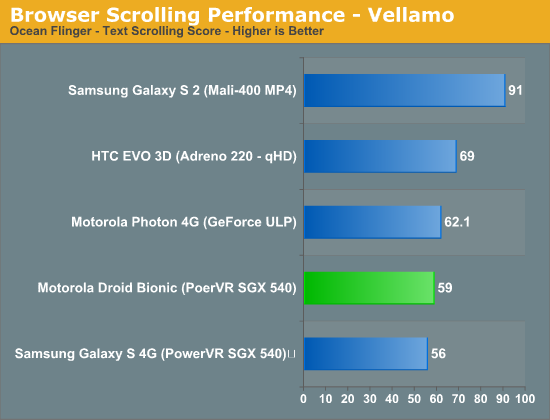
Flash is a bit interesting - there was an update for Flash 10.3 on Android pushed out a while back that enabled NEON codepaths for OMAP4 based phones. I didn’t have the Droid 3 at the time, but the Bionic now shows an improvement and is much closer to the cap for most of the test.

The rest of the tests are essentially the same as what we posted in the Droid Bionic preview piece, and reflect what we’ve seen before from OMAP4430.
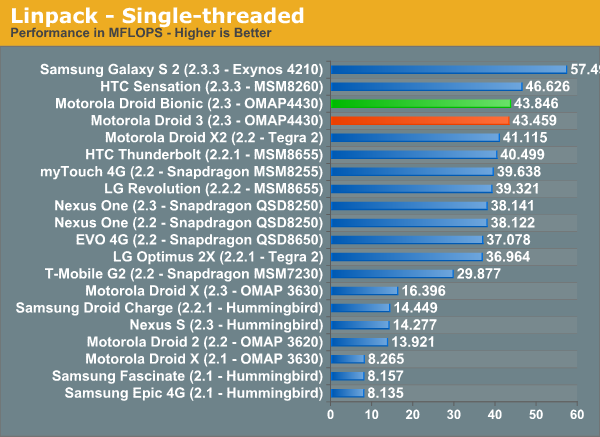
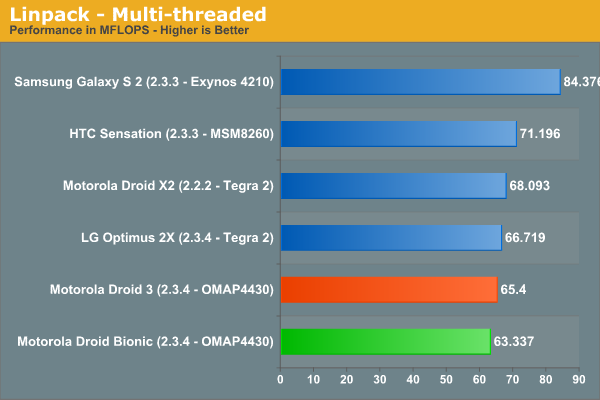
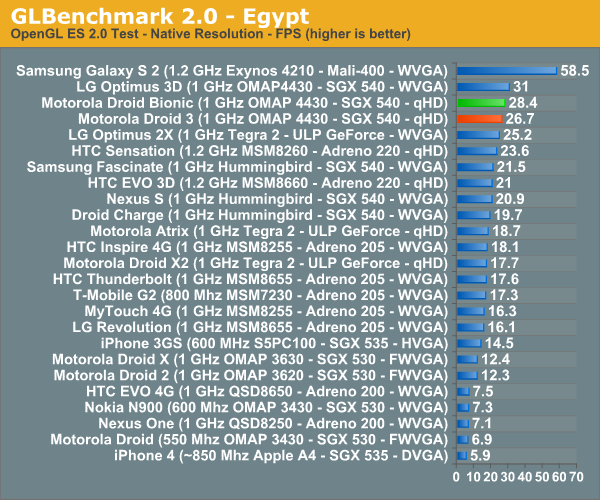
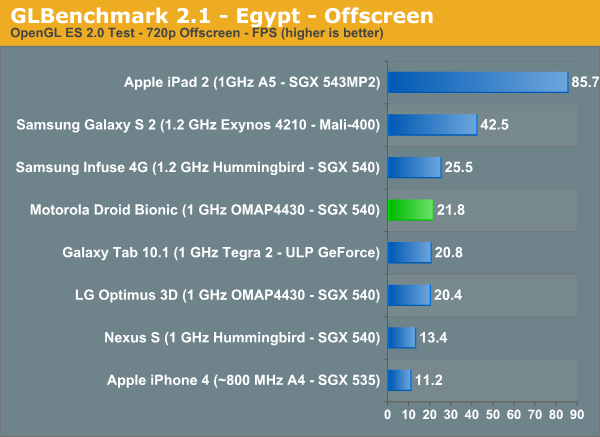
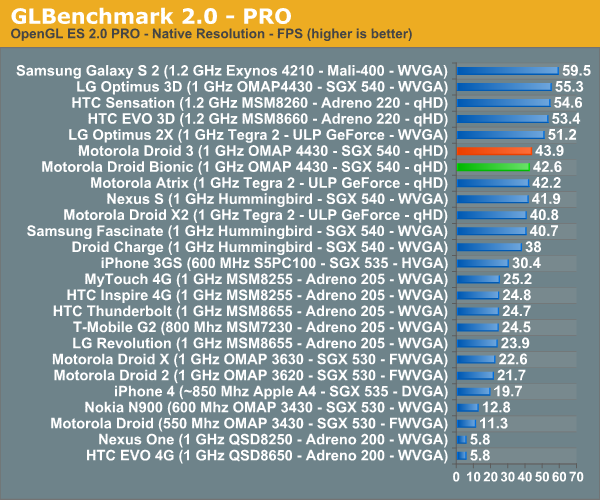
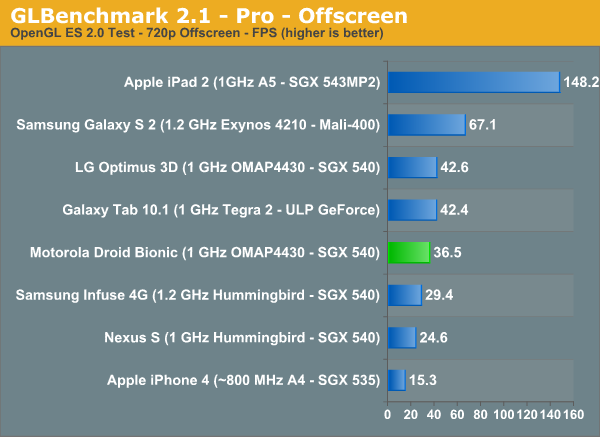
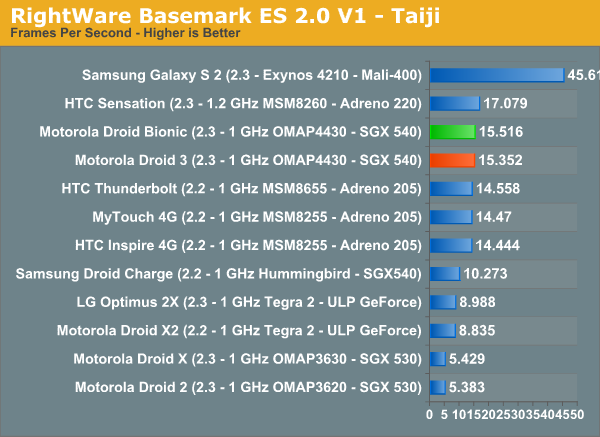
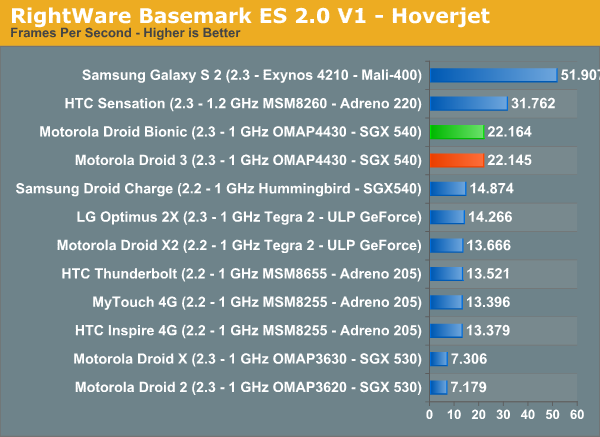
The results are unsurprising and completely in line with where they should be. The Bionic isn’t the absolute fastest of the dual core smartphones we’ve seen before, but it’s the first with LTE alongside it. The other question is how fast pages load on LTE compared to EVDO, I shot some video in our video review which really communicates things nicely.










64 Comments
View All Comments
Jamezrp - Tuesday, October 11, 2011 - link
Still going through the full review now...obviously quite a bit to get to. But I did want to say that Anand's first video review with the Apple Cinema Display was intriguing, and I enjoyed watching it. But this one, Brian...it just lacks the humanity. Seeing someone on the screen actually made me interested in watching, even with a complete lack of movement. Not sure if anyone else agrees, but if you guys are going to do video, I'd like to see faces talking intelligently, like you most certainly can.Brian Klug - Tuesday, October 11, 2011 - link
I've been doing videos in this format for a while now to show off the phone and keep it cropped nicely, but going forwards we're trying to find a way to merge the two styles.Doing something like what Anand usually does will require telepresence of some kind, however, but it's indeed a format we are working on.
-Brian
jackka - Tuesday, October 11, 2011 - link
Being able to see a talking face shouldn't matter much for phone reviews. People want to see the actual phone up close and in detail.It's not like we're watching the news or a talk show. The current format is simple and effective at its job. While I wouldn't mind more personality in the video, I definitely wouldn't trade it for any bit of the view or the detail of the actual phone that is being reviewed.
Much thanks for the video and the review, by the way.
Johnnn3433 - Saturday, November 5, 2011 - link
Is 4G LTE Speed Faster Than 4G or Even Faster Than 3G?www.fourgltephones.com
Jamezrp - Tuesday, October 11, 2011 - link
No worries, I totally get what you mean. I've stayed away from the camera for years...and every time I think of picking it up and putting myself on the screen, I stop myself for way too many reasons. I just think that you guys are clearly articulate enough to express exactly what need be said in a video, perhaps without even showing much of the product itself.Then again, it may depend on the product in question. I guess that still needs to be tested.
vol7ron - Wednesday, October 12, 2011 - link
Bad idea. Sure it's nice to see a face, maybe you want to use PIP by lockergnome does, but the review is about the device. You want to see how the device looks, how it interacts, it's something visual. You can get away with doing that for something like an SSD, CPU, or RAM, but if you're doing a video about a device that takes visual input or gives visual output, you better include it in the video.Jamezrp - Tuesday, October 11, 2011 - link
I've had the Bionic myself for a bit now, testing it...the biggest problem I've had (besides battery life) are the occasional software hiccups, which I didn't see you didn't seem to have Brian, or at least didn't mention. The worst is when I lose my cell data connection, the Bionic won't start up that connection again, period. I need to put it in sleep mode and wake it up, or reboot it entirely. Not even airplane mode switching fixes that.Other quirks include the awful shortcut-adding method, no settings in the drop-down menu, and a few more which escape me because it's late. On my model it even reads only 8GB of onboard memory, plus the 16GB card. The more I investigate, the more I think my model may be slightly defective...
Have you experienced any of these software problems?
I'll also add that I've had nearly identical benchmark scores. But I don't have the laptop dock...any plans on adding a section for that?
Brian Klug - Tuesday, October 11, 2011 - link
I honestly haven't experienced any of those issues at all - I've lost cellular data and had it come back no problems many times. Handover remains a problem for many of the LTE handsets however, where you'll either get stuck on EVDO until you reboot.Does airplane mode fix it at all? Sometimes these things really only can be remedied by a hardware swap, unfortunately.
No plans to add a section related to the laptop dock since Motorola didn't sample us one. However I'm told this is exactly the same as the Atrix, you can check out Anand's experience with that in his review though: http://www.anandtech.com/show/4165/the-motorola-at...
-Brian
bplewis24 - Tuesday, October 11, 2011 - link
You may have a lemon, because I don't have any of those issues.Hubb1e - Tuesday, October 11, 2011 - link
Mine has been flawless as well. Sounds like a lemon. The extended battery turns this into a great phone for power users and doesn't add that much bulk. I'm very happy with mine.